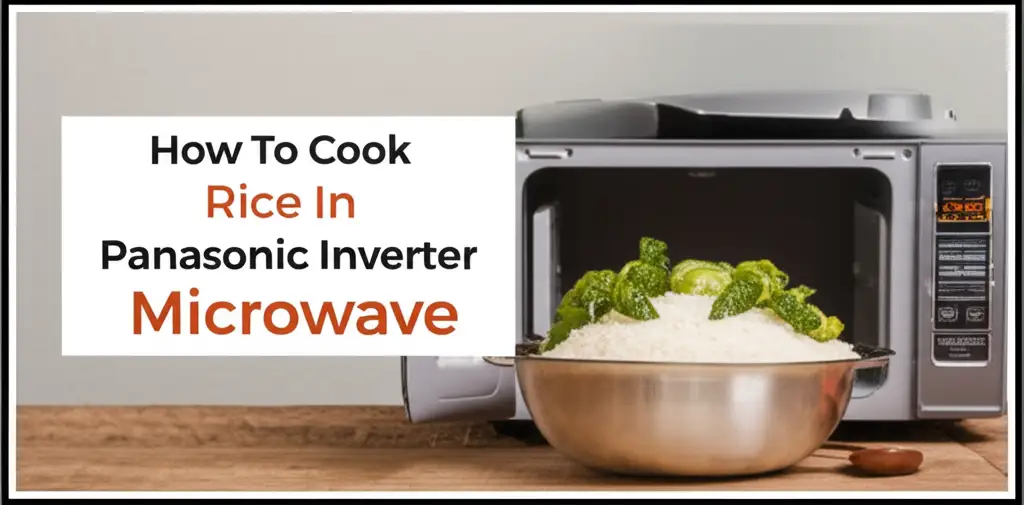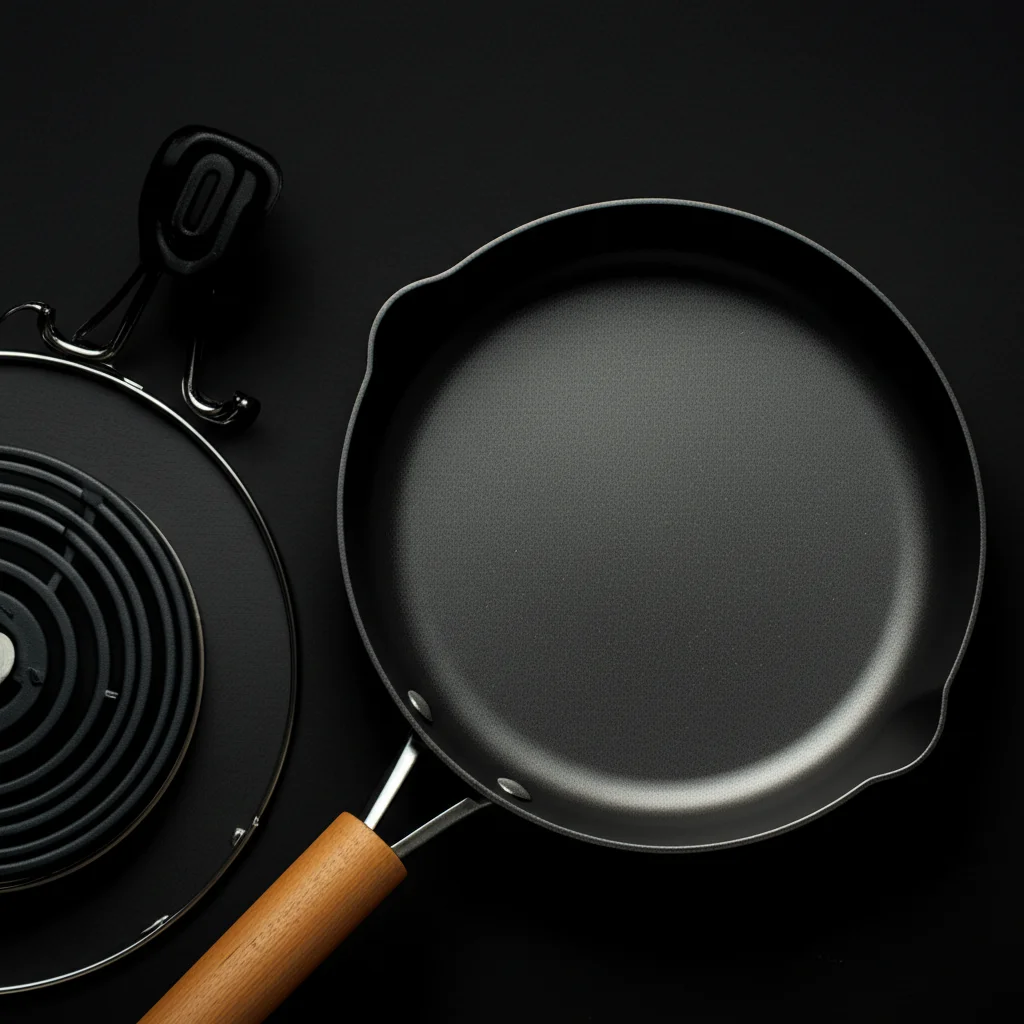· Todd Martin · Kitchen Care · 17 min read
How To Cook Rice In Panasonic Inverter Microwave

How To Cook Rice In Your Panasonic Inverter Microwave
Are you tired of mushy, sticky, or undercooked rice? Cooking rice can feel like a delicate art. Many people struggle to get it right on the stovetop. But what if I told you your Panasonic Inverter Microwave could be your secret weapon for perfect rice every time? It sounds surprising, yet this kitchen appliance offers incredible precision.
This guide will show you exactly how to cook rice in Panasonic Inverter Microwave models. We will cover choosing the right rice. We will also explore essential water ratios and precise cooking times. You will learn the simple steps to achieve fluffy, restaurant-quality rice. Forget uneven cooking; your inverter microwave ensures consistent results. Let’s make cooking rice easy and enjoyable.
Takeaway
- Choose the Right Rice: Select your preferred rice type, such as white long-grain, basmati, or jasmine.
- Rinse Thoroughly: Wash rice under cold water until the water runs clear to remove excess starch.
- Use Proper Water Ratios: Follow specific water-to-rice ratios for each rice type to ensure optimal texture.
- Select a Microwave-Safe Dish: Use a deep, microwave-safe bowl with a lid that allows steam to escape.
- Cook at Medium Power: Use 50-60% power (around 600-700 watts) for gentle, even cooking to prevent boil-overs.
- Rest After Cooking: Allow rice to rest, covered, for 5-10 minutes after cooking for moisture redistribution.
- Fluff and Serve: Gently fluff the cooked rice with a fork before serving.
Clear Answer
To cook rice in a Panasonic Inverter Microwave, combine rinsed rice with the correct water ratio in a deep, microwave-safe dish with a lid. Cook on medium power (around 50-60%) for 15-20 minutes, then let it rest for 5-10 minutes. This method ensures even heat distribution, resulting in perfectly fluffy rice.
Understanding Your Panasonic Inverter Microwave for Rice
The Panasonic Inverter Microwave is a powerful kitchen tool. It uses advanced inverter technology. This technology differs from traditional microwaves. Traditional microwaves cycle power on and off. This can lead to hot spots and uneven cooking. However, inverter technology provides a constant, steady stream of power. This means your food cooks more evenly. For rice, this is a game-changer.
When you cook rice, consistent heat is crucial. Inverter technology delivers this consistent heat. It cooks grains from the inside out. This prevents dry spots or mushy patches. Your rice will absorb water evenly. It will cook uniformly. This results in fluffy, tender grains. This even cooking also means less chance of boil-overs. You get reliable results every time. My experience shows that this consistent power truly makes a difference. It makes cooking rice simple and worry-free.
Using your Panasonic Inverter Microwave for rice is efficient. It saves energy compared to a stovetop. It also frees up your stove burners for other dishes. This makes meal preparation smoother. You simply set it and forget it. The microwave handles the rest. This appliance is designed for convenience and performance. Understanding its unique heating method is the first step to mastering perfect microwave rice. You can trust this technology for consistent cooking.
Choosing the Right Rice and Preparing It
Selecting the correct type of rice is the initial step towards success. Different rice varieties behave differently when cooked. Long-grain white rice, like jasmine or basmati, is popular. It cooks up light and fluffy. Short-grain rice, like sushi rice, becomes stickier. Brown rice needs more water and a longer cooking time. Each type of rice has its unique characteristics. Understanding these differences helps you achieve your desired texture. I often choose jasmine rice for its fragrant aroma and fluffy texture.
Once you select your rice, proper preparation is vital. Rinsing the rice is a crucial step. This removes excess starch. Starch can make your rice sticky or gummy. To rinse, place the rice in a fine-mesh sieve. Hold it under cold running water. Continue rinsing until the water runs clear. This usually takes a minute or two. You will notice the cloudy water becoming clear. This simple act significantly improves the rice texture. For more detailed instructions on this essential step, explore our guide on how to clean rice.
Some rice types benefit from soaking. Brown rice often benefits from a 30-minute soak. This helps it cook more evenly. It also reduces cooking time slightly. Soaking allows the grains to absorb water before cooking. This leads to a more consistent texture. For white rice, soaking is optional. I sometimes soak white rice for 15 minutes. This can make it even fluffier. However, it is not always necessary for good results. Preparing your rice correctly sets the foundation for perfect microwave cooking.
Perfect Water Ratios for Fluffy Microwave Rice
The water-to-rice ratio is arguably the most critical factor for perfect rice. Too much water leads to mushy rice. Too little results in dry, undercooked grains. Unlike stovetop cooking, microwave rice often requires slightly less water. This is because less water evaporates during the microwave cooking process. The sealed or partially sealed dish retains more moisture. This is a key difference to remember.
Here are general water ratios for common rice types:
- Long-Grain White Rice (Jasmine, Basmati): Use 1.5 to 1.75 cups of water for every 1 cup of rice. For fluffy rice, I start with 1.5 cups of water. If I want it slightly softer, I increase it to 1.75 cups.
- Short-Grain White Rice (Sushi, Arborio): Use 1.25 to 1.5 cups of water for every 1 cup of rice. This ratio helps maintain its characteristic sticky texture.
- Brown Rice: This type needs more water and a longer cooking time. Use 2 to 2.25 cups of water for every 1 cup of brown rice. Soaking brown rice before cooking can also improve results.
- Wild Rice: This is not technically rice but a grass. It requires even more water, typically 3 cups of water per 1 cup of wild rice. It also takes significantly longer to cook.
These ratios are starting points. You may need to adjust them based on your specific rice brand or microwave model. Some microwaves heat more efficiently than others. The age of your rice can also affect water absorption. Older rice might need a tiny bit more water. I recommend keeping a small notebook. Jot down the ratios that work best for your kitchen. This helps you refine your technique over time. Achieving the ideal water ratio ensures your rice comes out perfectly fluffy and tender.
Step-by-Step Guide: Cooking Rice in Your Panasonic Inverter Microwave
Cooking rice in your Panasonic Inverter Microwave is straightforward. Follow these steps for perfect results. You will find this method simple and efficient. My family often relies on this technique for quick meals.
Gathering Your Essentials
First, gather what you need. You will require:
- Your chosen rice (white, brown, or other).
- Cold water.
- A deep, microwave-safe dish with a lid. The dish should be at least double the volume of the uncooked rice and water combined. This prevents boil-overs. Ensure the lid has a small vent or can be placed slightly ajar. This allows steam to escape.
- A measuring cup for precise ratios.
Rinsing and Soaking Rice
As discussed, rinsing is important.
- Measure your desired amount of rice. For one serving, I use about 1/2 cup of dry rice.
- Place the rice in a fine-mesh sieve.
- Rinse under cold running water. Do this until the water runs clear. This removes extra starch.
- Optional: For brown rice or if you want extra fluffy white rice, soak it. Place the rinsed rice in your microwave-safe dish. Add the cooking water. Let it soak for 15-30 minutes. Drain the soaking water if you are following a recipe that specifies draining. Otherwise, use the soaking water as part of your cooking water.
Combining Rice and Water
- Put the rinsed (and optionally soaked) rice into your deep, microwave-safe dish.
- Add the correct amount of cold water based on your rice type. For 1 cup of white rice, I add 1.5 cups of water.
- Add a pinch of salt to the water, if desired. This enhances the flavor. A small amount of butter or oil can also be added. This prevents sticking and adds richness.
- Stir the rice and water gently once. Do not overmix.
- Cover the dish with its lid. Ensure the lid is vented or slightly ajar. This allows steam to escape safely.
Setting the Microwave Power and Time
This is where your Panasonic Inverter Microwave shines. Its consistent power is key.
- Place the covered dish in the microwave.
- Set the power level. For most rice types, I use medium power. This is typically 50% to 60% of your microwave’s total power. This translates to about 600-700 watts for a 1000-watt microwave. Lower power ensures even cooking and prevents boil-overs.
- Set the cooking time.
- For 1 cup of white rice (e.g., jasmine, basmati): Cook on 50-60% power for 15-20 minutes.
- For 1 cup of brown rice: Cook on 50-60% power for 30-40 minutes.
- For smaller batches (e.g., 1/2 cup white rice): Reduce cooking time slightly, perhaps 10-15 minutes.
- Do not open the lid during cooking. Let the steam do its work. Your Panasonic microwave makes setting these parameters easy. If you need a refresher on adjusting settings, our guide on how to set time on Panasonic Inverter Microwave NN-ST64JW can assist you.
Resting and Fluffing
Resting is a crucial final step.
- Once the cooking time finishes, carefully remove the dish from the microwave. Be careful, as it will be hot.
- Keep the lid on the dish. Let the rice rest undisturbed for 5-10 minutes. This allows the remaining steam to finish cooking the rice. It also lets the moisture redistribute evenly. This step makes the rice fluffy. Skipping it can result in a gummy texture.
- After resting, remove the lid. Use a fork to gently fluff the rice. This separates the grains. It releases any remaining steam.
- Your perfectly cooked rice is now ready to serve. Enjoy your light and fluffy microwave rice!
Troubleshooting Common Rice Cooking Issues
Even with an excellent Panasonic Inverter Microwave, cooking rice can sometimes present challenges. Knowing how to address common issues ensures you get perfect results every time. I have faced these problems myself and learned quick fixes.
Mushy Rice
If your rice turns out mushy, it likely received too much water or cooked for too long.
- Too Much Water: Reduce the water slightly for your next batch. Try decreasing by 1/4 cup per cup of rice. Remember that less water evaporates in a microwave compared to a stovetop.
- Overcooked: The rice might have cooked for too long at a high power setting. Reduce the cooking time by a few minutes. Also, ensure you are using a medium power level (50-60%) as recommended. This provides gentler, more even heat.
- Not Rinsed: If rice is not rinsed well, excess starch can cause stickiness, making it feel mushy. Always rinse thoroughly until the water runs clear.
Dry or Undercooked Rice
Dry, hard, or undercooked rice indicates insufficient water or cooking time.
- Not Enough Water: Increase the water by 1/4 cup per cup of rice for your next attempt. The grains need enough moisture to fully absorb and expand.
- Undercooked: The cooking time might have been too short. Add a few more minutes to the cooking time. Also, ensure your microwave is operating at the correct power level. Sometimes, individual microwaves vary.
- Not Resting: The resting period is critical. If you skip it, the rice might seem undercooked even if it has absorbed enough water. The rest allows steam to finish cooking and moisture to redistribute. Always allow 5-10 minutes of resting time with the lid on.
Boil-Over
A boil-over happens when starchy water bubbles out of the dish during cooking. This creates a mess.
- Dish Too Small: Your cooking vessel might be too small. Always use a deep, microwave-safe dish. It should be at least double the volume of the uncooked rice and water combined. This provides ample space for expansion and bubbling.
- Too High Power: Cooking at full power (100%) often causes boil-overs. The rapid boiling pushes water out. Always use a medium power setting (50-60%). This allows a gentle simmer, which is ideal for rice.
- Lid Not Vented: Ensure your dish’s lid has a small vent. If not, position the lid slightly ajar. This allows steam to escape safely. Proper ventilation prevents pressure buildup and excessive bubbling.
By understanding these common issues and their solutions, you can confidently adjust your approach. Each microwave can be slightly different. A little experimentation often leads to perfect results.
Tips for Elevating Your Microwave Rice
Cooking basic rice in your Panasonic Inverter Microwave is just the beginning. You can easily elevate its flavor and texture. These simple additions can transform a side dish into something special. I love experimenting with these tips to add variety to my meals.
Adding Flavor and Texture Boosters
- Salt: Always add a pinch of salt to the water before cooking. This simple step enhances the rice’s natural flavor. It makes a big difference.
- Oil or Butter: A teaspoon of neutral oil (like vegetable or canola) or butter added to the water can prevent sticking. It also makes the grains separate beautifully. This gives a lovely, glossy finish to your rice.
- Broth Instead of Water: Replace some or all of the water with chicken, vegetable, or beef broth. This infuses a deep, savory flavor into your rice. It is perfect for serving with roasted meats or stews.
- Herbs and Spices: Add dried herbs like parsley or cilantro for a subtle aroma. For a bolder taste, consider a pinch of garlic powder or onion powder. A bay leaf added to the cooking water also imparts a nice background note. Remove the bay leaf before serving.
- Aromatics: For an extra layer of flavor, consider adding a slice of ginger or a smashed garlic clove to the cooking water. Remove them before serving.
- Lemon or Lime Zest: A tiny bit of fresh citrus zest stirred in after cooking adds brightness. This is particularly good with fish or chicken dishes.
Using Microwave Rice Cooker Accessories
Some Panasonic microwaves or third-party brands offer specific microwave rice cooker accessories. These often consist of a large, deep bowl with a pressure-regulating lid. They are designed to prevent boil-overs and optimize steam circulation. While not strictly necessary, they can make the process even more foolproof. If you frequently cook large batches of rice, investing in one of these can be beneficial. They ensure a consistent cooking environment.
Storing Leftover Rice
Properly storing leftover rice is important for safety and quality.
- Cool cooked rice quickly. Spread it on a shallow plate. This helps it cool within an hour.
- Once cooled, transfer the rice to an airtight container.
- Store it in the refrigerator. Consume leftover rice within 1-2 days.
- When reheating, add a tablespoon of water per cup of rice. Cover it and microwave until hot. This prevents it from drying out.
You can even prepare flavored rice dishes in the microwave, similar to how you might prepare boxed mixes. For example, learning how to microwave Zatarain’s yellow rice can give you ideas for adapting other rice types. These small enhancements make your Panasonic Inverter Microwave an even more versatile cooking tool.
Comparing Microwave Rice to Other Methods
Cooking rice offers many methods. Each has its pros and cons. Understanding these differences helps you appreciate the convenience of your Panasonic Inverter Microwave. I have tried them all over the years.
Stovetop Rice
This is the traditional method. Rice is cooked in a pot on the stove.
- Pros: It offers precise control over heat. You can easily adjust the boil. It works for any quantity.
- Cons: Requires constant monitoring to prevent sticking or boil-overs. It ties up a burner. It is prone to uneven cooking if not managed well. The bottom can sometimes burn.
Dedicated Rice Cookers
Many households use specialized electric rice cookers.
- Pros: Excellent consistency. They are designed specifically for rice. Often include “keep warm” functions. They are very hands-off once set.
- Cons: Takes up counter space. It is a single-purpose appliance. Cooking times can be longer than microwave or stovetop.
Slow Cookers
Some slow cookers can cook rice.
- Pros: Very hands-off. It can be part of a larger meal cooked in the same pot.
- Cons: Extremely long cooking times. The texture can be less fluffy, sometimes tending towards mushy. It is not ideal for quick rice. If you are curious about this method, you can learn more about does slow cooker cook rice.
Air Fryers
While not a primary rice cooking method, some people experiment with it.
- Pros: Can sometimes achieve unique textures for fried rice.
- Cons: Not suitable for basic steamed rice. Limited capacity. Requires specific accessories. It is generally inefficient for traditional rice cooking. This method is explored in guides like can you cook rice in Gourmia air fryer.
Panasonic Inverter Microwave
This method balances speed and quality.
- Pros:
- Speed: Much faster than traditional rice cookers or slow cookers.
- Convenience: Hands-off cooking. No need to monitor a pot. Frees up stovetop burners.
- Even Cooking: Inverter technology ensures consistent heat. This prevents hot spots and results in uniformly cooked rice.
- Easy Cleanup: Uses a single dish. Less scrubbing than a burnt stovetop pot.
- Space-Saving: Uses an appliance you likely already own. No need for another gadget.
- Cons:
- Capacity Limits: Best for small to medium batches. Large family-sized portions might require multiple runs or a very large microwave-safe dish.
- Learning Curve: Requires finding the right water-to-rice ratio and power settings for your specific microwave.
- Lack of Control: Once set, you have less fine-tuning ability compared to stovetop methods.
Ultimately, the Panasonic Inverter Microwave offers a fantastic balance of speed, convenience, and quality for cooking rice. Its consistent heat delivery makes it a superior option for busy cooks seeking perfect results without the fuss.
FAQ Section
Can I cook brown rice in a Panasonic Inverter Microwave?
Yes, you can cook brown rice. Brown rice requires more water and a longer cooking time than white rice. Use about 2 to 2.25 cups of water per 1 cup of brown rice. Cook on 50-60% power for 30-40 minutes. Always allow a 10-minute rest period.
What kind of dish should I use for microwave rice?
Use a deep, microwave-safe bowl. It should be at least double the volume of your uncooked rice and water combined. This prevents boil-overs. The dish needs a lid that can vent. This allows steam to escape while cooking.
How do I prevent boil-over when cooking rice in the microwave?
To prevent boil-overs, use a sufficiently large, deep dish. Do not fill it more than halfway. Cook the rice on a medium power setting (50-60%) instead of full power. Ensure your lid is vented or slightly ajar. These steps prevent excessive bubbling.
Do I need to soak the rice before microwaving?
Soaking rice is generally optional for white rice, but it can lead to fluffier results. For brown rice, soaking for 30 minutes is recommended. This helps the grains absorb water. It also reduces overall cooking time. Soaking can improve consistency.
Why is my microwave rice sticky or gummy?
Sticky or gummy rice often results from too much starch or too much water. Ensure you rinse the rice thoroughly before cooking. Use the correct water-to-rice ratio. Also, make sure you let the rice rest, covered, for 5-10 minutes after cooking. This allows moisture to redistribute.
Can I cook a large batch of rice in the microwave?
Microwave capacity limits large batches. It is best suited for small to medium portions (1-2 cups of dry rice). For very large amounts, you might need a dedicated rice cooker or stovetop method. Attempting too much rice can lead to uneven cooking or boil-overs.
Conclusion
Cooking perfect rice in your Panasonic Inverter Microwave is not only possible but also incredibly easy. We have explored the crucial steps to achieve consistently fluffy results. You now understand the benefits of inverter technology. You also know the importance of correct water ratios and cooking times. From selecting your rice to the final fluffing, each step contributes to success.
My experience shows this method is a game-changer for busy households. It offers convenience without sacrificing quality. No more burnt bottoms or mushy grains. Your Panasonic Inverter Microwave is a precise tool. It ensures your rice is always ready to complement any meal. Take these tips to your kitchen. Experiment with different rice types and flavors. Embrace the simplicity of microwave rice. You will wonder how you ever cooked it differently. Go ahead and try it. Enjoy perfect, fluffy rice with minimal effort tonight!
- Panasonic microwave
- inverter microwave
- cook rice
- microwave rice
- rice cooking tips
- kitchen hacks
- cooking guide





